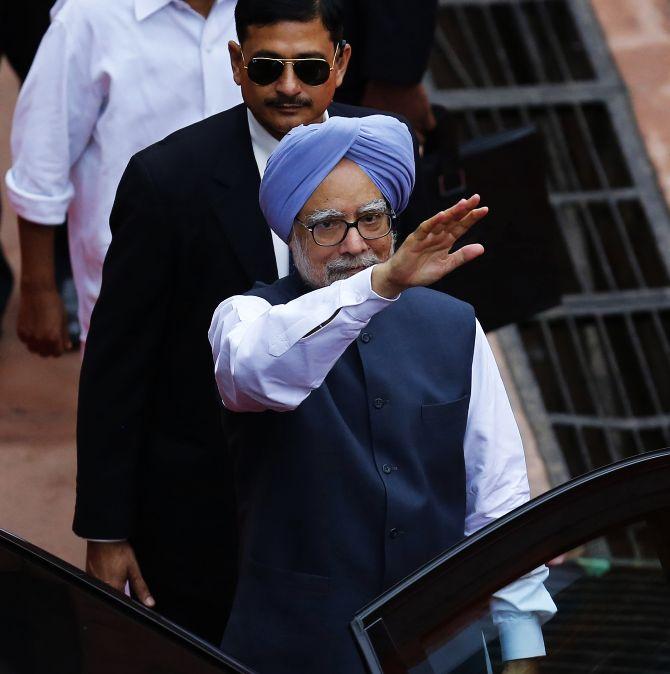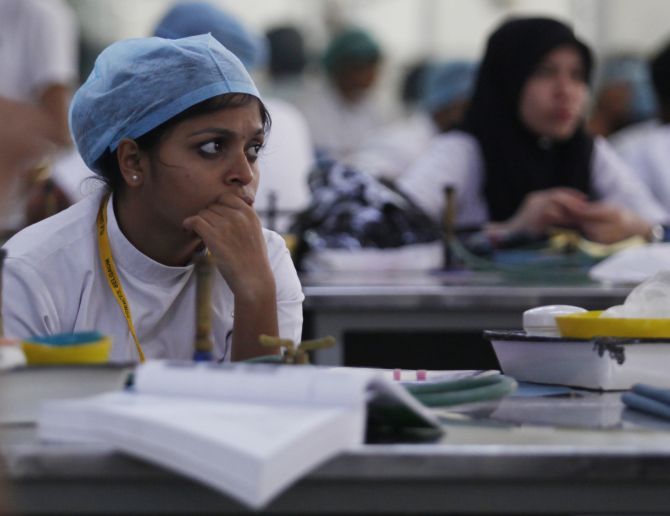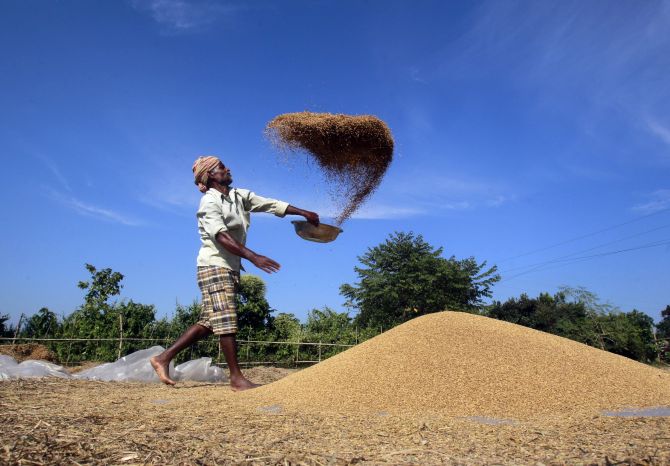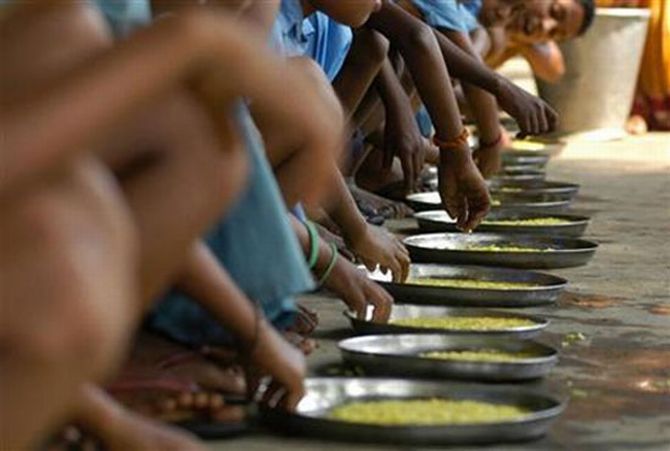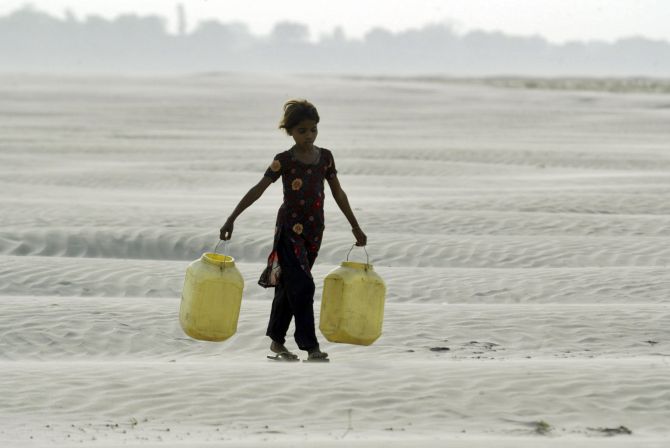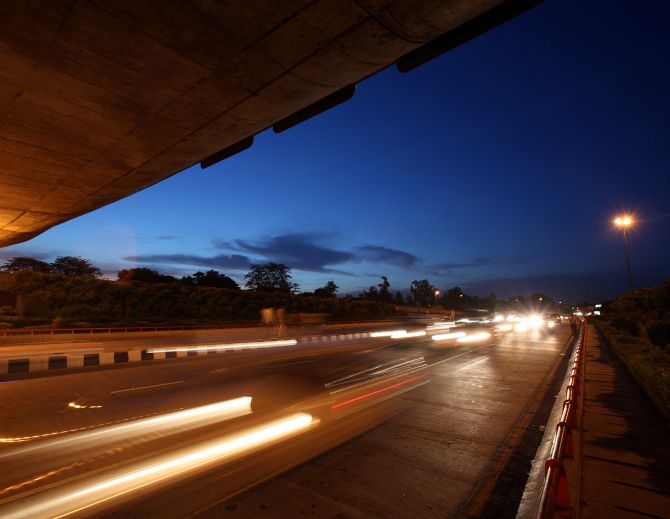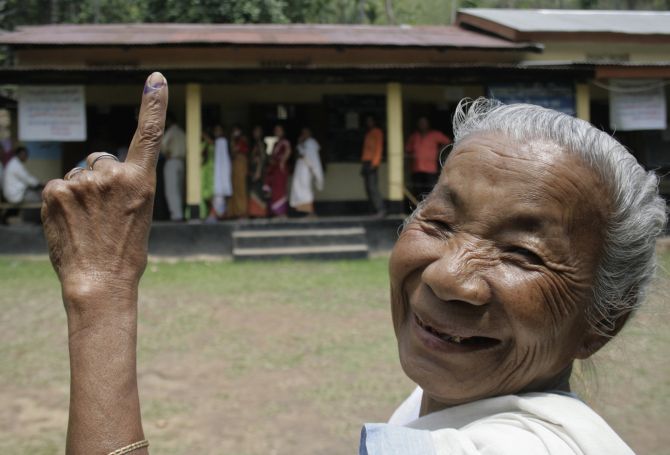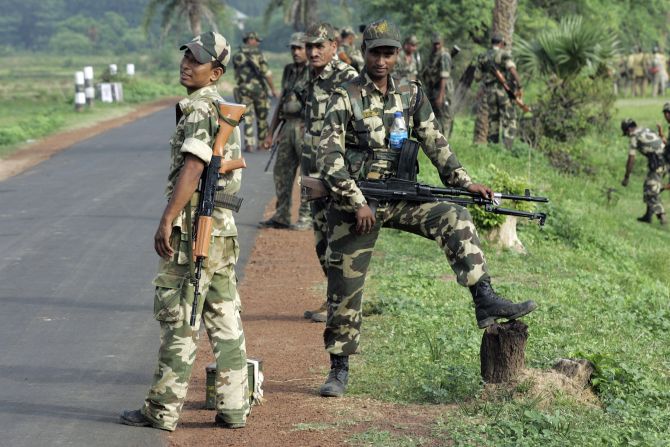 | « Back to article | Print this article |
The SHIELD Manmohan Singh is counting on
As Prime Minister Manmohan Singh readies to face some tough questions in his interaction with mediapersons on Friday, he will largely base his arguments on a performance report of the United Progressive Alliance government.
The report, which has been accessed by Rediff.com, chalks out the achievements of the UPA government in great detail. Here are the salient features of the report.
Click here to read the full report
Kindly click NEXT to read further…
'Better education'
The UPA government has continuously increased outlays for education in the Five Year Plans which has resulted in more students attending schools and colleges, the report notes.
Central Universities increased from 17 to 44 during 2004 to 2013. 9 IITs were added to the 7 existing IITs during the period. Number of IIMs more than doubled from 6 to 13 in the period. Five IISERs and 2 IIITs were also added in the period, the report adds.
“The Right to Education Act brought in by the UPA government has improved enrolment in schools across the nation. The country has achieved the goal of near universal education at the primary school level. Dropout rate in schools have declined raising the retention of students in middle and secondary levels,” the report notes.
“In a historic step, the UPA government enacted the Right of Children to Free and Compulsory Education Act, 2009, which has led towards universalisation of education for children between 6 to 14 years of age. Since the enactment of the Act, 30,888 primary school buildings, 10,644 upper primary school buildings, 6,88,385 additional classrooms, 5,18,700 toilets facilities and posts of 7,00,475 teachers have been sanctioned,” the report points out.
Kindly click NEXT to read further…
Farmers' welfare
“To ensure farmers' welfare, the UPA government has been steadily enhancing the minimum support price for various farm products. MSP for both wheat and paddy has more than doubled from 2004-05 to 2012-13. MSP for other cereals has been increased three-fold and is now better than for wheat and rice MSP in our efforts to support marginal farmers who produce cereals,” the report notes.
“Agriculture credit has been increased to the tune of 700 per cent under the UPA government. More than 650 lakh farmers were financed by the banking system during the year 2012-13,” the report states.
“In 2013, India exported agricultural products worth $41 billion against an agri-import of only $ 20 billion, giving a net surplus of $ 21 billion. Share of Indian agri-exports in global agri-exports increased from 0.8 per cent in 1990 to 2.6 per cent in 2012,” the report adds.
Kindly click NEXT to read further…
Ensuring food security
“There has been a more than three-fold increase in food subsidy during the UPA tenure. It reflects government's commitment to ensure adequate food at affordable prices for all, especially the poor,” the report points out.
“The UPA government has enacted the National Food Security Act which legally entitles families under Antyodaya Anna Yojana for 35 kg of food-grains per month and other families for 5 kg per person at subsidised rates under the Public Distribution System.
“To keep pace with the UPA government's resolve to provide food and nutritional security to the people, especially the poor, efforts to increase food-grains production have yielded results.
“Efforts in strengthening agriculture sector have led to record production of food-grains since 2004.
‘Rural employment’
“The Mahatma Gandhi National Rural Employment Guarantee Act is the largest social welfare scheme of its kind in the world started by the UPA in 2006. Every fifth rural household in India benefits from the scheme which provides employment mostly to the Scheduled Castes, Scheduled Tribes and women in villages,” the report points out.
“Wages given under MGNREGA per day have almost doubled from Rs 65 to Rs 128 since the launch of the scheme. In 2012-13, the scheme provided employment to more than 4.8 crore households, generating more than 213 crore person- days of employment,” the report adds.
‘Healthcare’
“Consistent investments in public health are showing better results as the infant mortality rate, Maternal Mortality Rate and Life Expectancy levels improved steadily. After the Rural Health Mission, a National Health Mission has been launched which will include urban poor better health services.
“Absence of new endemic polio cases for the last two years is an achievement that has been hailed at international forums.
“With health interventions during pregnancy and at birth, infant mortality rate has reduced from 58 per 1000 live births in 2004 to 44 per 1000 live births in 2011,” the report notes.
‘Social security for special sections of the society’
“The UPA government has always accorded high priority to the welfare of minorities. There has been a ten-fold increase in the expenditure on minorities since 2004-05. Minorities are benefitting from the PM's new 15 point programme, the multi-sectoral development programme and the various scholarship schemes for minority students,” the report points out.
Kindly click NEXT to read further…
Economic growth
“Per capita income in India has increased almost three-fold since the UPA government came to power. As a result of the policies of inclusive growth, real wages in agriculture have increased 6.8 per cent during the 11th Five Year Plan (2007-12) as opposed to 1.1 per cent during the 9th and 10th Five Year Plans earlier,” the report notes.
“Average GDP growth rate during the period of the UPA government (2004-05 to 2013-14) has been 7.7 per cent despite two global slowdowns in this period.
“Agriculture growth rate has been rising consistently. It was 2.5% and 3.7% during 10th and 11th Plans, respectively,” the report points out.
‘Financial inclusion’
“Rapid economic growth and enhancement in wealth has spurred financial inclusion of the population as never before. The total number of accounts under pension fund has increased from four crore in 2002-03 to more than 16 crore by 2011-12. Total enrolment in employees pension funds has increased from 3.95 crore to 8.85 crore,” the report states.
‘Improving unemployment’
“Unemployment rate in the country is steadily declining due to the UPA government's economic policies. Average industrial growth during 2004-05 to 2011-12 has been the highest ever at 8.5 per cent per annum creating productive employment for young people.
“National Skills Development Authority has been working with other stake holders, including the private sector, to train 50 million people for the workforce during next 5 years,” the report notes.
Kindly click NEXT to read further…
Poverty reduction
“Under the UPA government, poverty in India has declined in an unprecedented manner. Average decline in poverty was 2 per cent per annum during 2004-12, almost twice the rate of the preceding decade.
“The government launched 16 flagship programmes both in rural and urban areas during the XI Five Year Plan and allocations for them have been more than doubled under the XII Five Year Plan,” the report notes.
‘Rural welfare’
“Consumption has increased phenomenally in India both in urban and rural areas as fruits of economic growth reached the common man. Due to the UPA government's pro-poor policies, consumption in rural areas registered an increase of 3.4 per cent which was only 0.8 per cent during 1999 to 2004. Rural wages have increased @16 per cent each year,” the report adds.
“In the last 9 years, since 2004-05, wages for rural workers have tripled improving the purchasing power of the majority of the people in villages,” the report notes.
‘Direct benefit transfers’
“Using broadband and information technology, the Unique Identification Authority of India has issued more than 500 million Aadhaar cards across the country which are enabling people to receive direct benefit transfers in 121 districts. More than one crore households are now availing direct benefit transfer for LPG in 182 districts across the country,” the report points out.
Kindly click NEXT to read further…
Infrastructure
“More than 2 lakh kilometers of new roads have been added to the rural road network. Allocation for Pradhan Mantri Gram Sadak Yojana has been increased 88 per cent in the 12th Five Year Plan to further improve rural connectivity. 17,394 kms of highways were built or upgraded in the last 9 years by the National Highways Authority of India,” the report notes.
‘Power generation capacity’
“India has added power generation capacity in the last 9 years than in the entire preceding period since Independence. Per Capita Consumption of Electricity has gone up from 559 kWh in 2002 to 813 kWh in 2011,” the report points out.
‘Connectivity’
“Telephone density in rural areas has increased 25 times during the tenure of the UPA government. India has one of the lowest telecom prices in the world making telephones accessible to the poor. Those who cannot afford private phones are being provided connectivity through village level telephony.
“Broadband will reach 2.5 lakh villages by 2014. Internet and Broadband Services have increased more than 100 times during the UPA tenure,” the report notes.
Kindly click NEXT to read further…
Development of North East region
“We have earnestly worked for development and peace in the North Eastern region through special initiatives. Growth in the region is better than the national average. Internal security in the North Eastern states improved considerably with a steep decline in extremism related violent activities due to developmental process becoming robust. The UPA government invested public funds in major infrastructure projects in the region which led to better economic growth,” the report states.
“Growth rate of the North Eastern region is now higher than the national average due to the special attention given by the central government. It has now been mandated that all central government ministries allocate 10 per cent of their plan budgets for the NE region.
“Major extremist groups were engaged in peaceful dialogue and many of them joined the political mainstream of the region,” the report says.
Kindly click NEXT to read further…
Ensuring safety and security
“The UPA government's approach in dealing with left-wing extremism in a holistic manner in the areas of security, development, ensuring rights of local communities and good governance is showing results in declining violence in LWE affected areas. In the last four years, lives lost in LWE-related incidents were reduced by more than half,” the report states.
“The situation in Jammu and Kashmir has shown vast improvement as the government has worked with people of the state to restore normalcy and encouraged development in equal measure. Security situation in the state of Jammu & Kashmir has rapidly improved after UPA government came to power and implemented policies for relief and rehabilitation in the militancy affected areas,’ the report adds.
